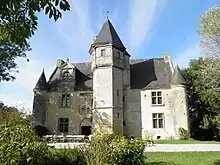Robert du Mesnil du Buisson
Count Robert du Mesnil du Buisson (9 April 1895, Champobert, Bourges – 8 April 1986, Caen) was a French historian, soldier, and archeologist. He was noted for his early use of geophysical survey for archaeology.[1][2][3] He was son of Auguste, comte du Mesnil du Buisson and Berthe Roussel de Courcy, and married Jeanne Leclerc de Pulligny on 26 June 1923.[4]
Soldier
Mesnil du Buisson volunteered in 1914, before the call-up, and was lieutenant in the 6th Regiment of chasseurs à cheval. He was awarded chevalier de la Légion d'Honneur for bravery.
He volunteered again in 1939, as commander of a squadron of the cavalerie de réserve, fighting in Belgium and France in 1940 then joining the resistance in Normandy. He was elevated to commandeur de la Légion d'Honneur and commandeur de l'ordre des Arts et des Lettres. His other medals included the croix de guerre 1914-1918 and 1939–1945, croix du combattant volontaire, with medals of Verdun, of Syria and of the Resistance.
Archeologist
He was director of excavations at Qatna (el-Mishrifeh: 1924, 1927–29), Til-Barsip (Tell el-Ahmar: 1927, 1929–31), Hadatu (Arslan Tash, 1928), and was vice-director of excavations at Dura-Europos from 1932 to 1937 coordinated between Yale University led by Clark Hopkins and the French Académie des inscriptions et belles-lettres.[5]
During 1932-1933, Count Robert du Mesnil du Buisson had conducted excavations in various locations in Syria and served as a captain in the French army.[6] He participated in the expedition of Dura-Europos acting as a representative of the French Academy.[6] He also conducted research and explored various facets of ancient archaeology in the Lebanese city of Beirut, including the city's defenses and topography.[7]
He discovered the Synagogue of Dura Europos and published on the synagogue's frescos in 1939. Among his other archeological finds were the Baalshamin and the Arslan Tash amulets.
Conservation work

From 1969 he became actively involved in work to preserve the Le manoir d'Argentelles at Villebadin. He died of injuries sustained in a car accident in 1986.
Publications
- La Technique des fouilles archéologiques. Les principes généraux, Paris, 1934
- La Basilique chrétienne du quartier Karm el-Arabis à Homs, Beirut, 1930
- Le Site archéologique de Mishrifé-Qatna, Paris, 1935
- Les Noms et signes égyptiens désignant des vases ou objets similaire, Paris, 1936
- Les peintures de la Synagogue de Doura-Europos, 245-246 après J.-C., Rome, 1939
- Le sautoir d'Atargatis et la chaîne d'amulettes 1947
- Le Manoir d'Argentelles : Sauvetage d'une œuvre d'art en péril, éd. Gallier, 1969
- Etudes sur les dieux phéniciens hérités par l'Empire romain 1970
- Nouvelles études sur les dieux et les mythes de Canaan 1973
References
- The Global History of Paleopathology: Pioneers and Prospects - Page 463 Jane Buikstra, Charlotte Roberts - 2012 "Count Robert du Mesnil du Buisson (1895–1986), a French precursor in geophysical survey for archaeology."
- Bulletin - Page 17 Société nationale des antiquaires de France - 1987 "Robert du Mesnil du Buisson, né à Champobert le 19 avril 1895, s'est éteint le 8 avril 1986 à Caen, des suites d'un accident de voiture survenu la veille à Argentan. Il a été inhumé le 12 avril à Villebadin, près de son manoir de Champobert.
- "Robert du Mesnil du Buisson", in Je m'appelle Byblos, Jean-Pierre Thiollet, H & D, 2005, p.255, ISBN 2 914 266 04 9.
- Hahn, Hans Peter; Klöckner, Anja; Wicke, Dirk (2022-03-24). Values and Revaluations: The Transformation and Genesis of 'Values in Things' from Archaeological and Anthropological Perspectives. Oxbow Books. p. 277. ISBN 978-1-78925-814-1.
- C. Hopkins, The discovery of Dura-Europos, ed. B. Goldman, 1979.
- Baird, Jennifer (2018-06-14). Dura-Europos. Bloomsbury Publishing. p. 12. ISBN 978-1-4725-2365-5.
- Paturel, Simone (2019-07-01). Baalbek-Heliopolis, the Bekaa, and Berytus from 100 BCE to 400 CE: A Landscape Transformed. BRILL. p. 12. ISBN 978-90-04-40073-3.